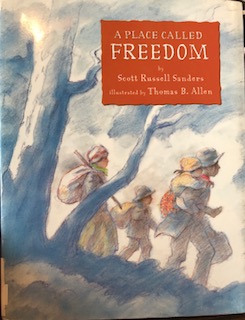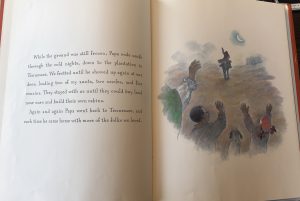
Title: A Place Called Freedom
Author: Scott Russell Sanders
Illustrator/Photographer: Thomas B. Allen
Publisher: Atheneum Books for Young Readers
Year: 1997
Number of Pages: 32
Tags: Culture, Emotion, Family, Historical Fiction, Picture Book, K-5, Taylor Krueger
Genre: Picture Book Historical Fiction
Analysis: This book shows the story of a family who was freed from slavery in the spring of 1832. James and his family travel by foot from Tennessee to Indiana where they decide to settle and create their home. Papa would continue to make the trip to rescue other freed slaves and runaways. The continued growth of the settlement led to the development of a civilized town, where schools and successful jobs formed. The village was named Freedom, and was seen as a magical place for James and his family.
The illustrations of this picture book do not contain borders and are seen to vanish off of the page. There is a representation of a window into the lives of the characters and their actions during this time period of slavery. It allows the reader to feel the emotions and struggles freed slaves had by the detailed illustrations. These images share the stories of the Starman family through their journey to a settled life after being freed from slavery. The illustrations capture the historical world of the past, and allow the reader to look through this window into the past.
The colors used throughout the book are light and give off the sense of calmness to the reader. There is not an urge of fear or worry for the characters of the book due to the c
olor choice. The use of bright colors throughout the book represent the newfound freedom of the characters. The lines of the illustrations are varied between thin, thick, and jagged lines as the images look like those of a “colored pencil drawing”. The lines are soft as there is not a presence of uneasiness from the drawings. The use of light textured drawings relate back to the time period of this book, and it represents the history of the time.
The drawings of the characters and setting have the perceptual view of a family settling and building a new settlement. There are depictions of the characters raising corn, handling horses, teaching children, and establishing a new life. The structural view of the characters show a representation of empowerment. There is a transformation seen from the facial expressions of the characters throughout the book as the beginning illustrations show sadness and worry which transforms to illustrations of happiness and freedom. The characters are often drawn the same size as there is not a hierarchy among them, but a vaguely mentioned group of people that still holds power over their ultimate freedom. This book shows the historical ideological issue of power and culture through the times of slavery. It shows the transformation of slaves moving towards freedom, but depicts the social issues of being enslaved. This book shares the story of families starting a new life, but allows young children to understand the struggles and wrongdoing of slavery.
issue of power and culture through the times of slavery. It shows the transformation of slaves moving towards freedom, but depicts the social issues of being enslaved. This book shares the story of families starting a new life, but allows young children to understand the struggles and wrongdoing of slavery.
This book is a representation of a multimodal text. There is an interaction between the iconic and conventional parts of children’s books. The illustrations elaborate the meaning of the text, and the words fill in the gaps of the illustrations. The illustrations develop the overall setting and characters throughout the text, as the reader can feel the emotion of the heartfelt images. The text and illustrations cooperate together in order to further elaborate the story that is told; they are both equally important in order for the meaning of the book to be shared to the reader.
